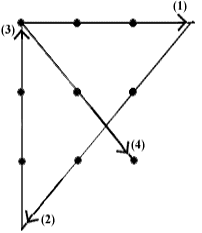
 |
Unfair! You didn't tell us we could go outside the square!
True! but I didn't tell you that couldn't either: the question simply
asks for four contiguously drawn straight lines and that's what this solution
provides! (There may well be others...!) This sort of abstract problem
tests your aptitude or IQ more than it does acquired knowledge, and you
won't encounter anything similarly abstract (or as complicated) in BI250.
Thinking about this problem and this solution, however, provides some
useful hints for BI250 problem-solving in general.
A. Understanding a problem is the first step in solving it.
- Read the problem carefully. Make sure you understand the language.
- Look at a problem from different perspectives. Solve the weekly problems with friends to gain their perspectives! Practice by yourself generating more than one solution to a problem.
- If you don't understand something on an exam, ask! (You may be told you should know the answer to the question you're asking, but sometimes you'll see an aspect of the problem that wasn't intended.)
B. Sometimes the answer to a problem (or an experiment, etc.) requires
an approach from outside the apparent boundaries of the problem.
C. If you encounter a BI250 exam question that seems as abstract (or
"foreign") as this one, it's probably covering material you
haven't studied and/or don't remember. In that instance, treat it as an
"aptitude" question and answer it as reasonably as you can.
Don't expect full credit for a "reasonable" answer if your vocabulary
or "facts" are limited (or wrong), but some credit is always
better than none!
D. While it's unlikely you will encounter any problem so abstract, you
will deal with more concrete spatial problems. Picturing data,
and drawing diagrams, may provide important hints for problem solutions.
Now for a question you're more likely to encounter on a BI250 exam...
Next Page>>